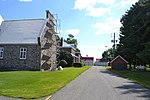Sainte-Madeleine, Quebec
Incorporated places in Les Maskoutains Regional County MunicipalityMontérégie geography stubsPages with non-numeric formatnum argumentsUse Canadian English from January 2023Villages in Quebec

Sainte-Madeleine is a village municipality in southwestern Quebec, Canada in Les Maskoutains Regional County Municipality. The population as of the Canada 2011 Census was 2,356. Le Camping Ste-Madeleine, founded in 1967 for visitors to EXPO 67, is the area's principal tourist attraction. The annual musical event, the Festival Country du Camping Sainte-Madeleine, held in late July, attracts approximately 5,000 visitors to the community of 2,356. Individuals born in Sainte-Madeleine include artist France Jodoin.
Excerpt from the Wikipedia article Sainte-Madeleine, Quebec (License: CC BY-SA 3.0, Authors, Images).Sainte-Madeleine, Quebec
Rue Desbiens,
Geographical coordinates (GPS) Address Nearby Places Show on map
Geographical coordinates (GPS)
| Latitude | Longitude |
|---|---|
| N 45.6 ° | E -73.1 ° |
Address
Rue Desbiens
Rue Desbiens
J0H 1S0
Quebec, Canada
Open on Google Maps









